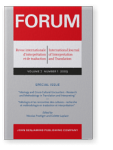La construction sémiotique de l’altérité dans les péritextes de la traduction de Julián Ribera de « L’histoire de la conquête de l’Espagne » d’ibn al Qutiyya de Cordoue
Anna Gil-Bardají | Faculté de Traduction et d’Interprétation, Université Autonome de Barcelone
This article works from the premise that translation, given its hybrid nature, plays a decisive role in constructing discourses of otherness and identity. Orientalist translation is an excellent source for studying the discourse of otherness, while also providing a wealth of information of how “Self” is perceived and represented. In the case of Spanish orientalism, the construction of such discourses is particularly complex due to the nature of the topic under study: al-Andalus, the Arabic name given to those parts of the Iberian Peninsula governed by Muslims at various times in the period between 711 and 1492. According to Martínez Montávez, al-Andalus has always had two facets: the real and historical which ended in 1492, the other figurative and symbolic which has survived until today. This article analyses the peritexts in the translation of a famous Andalusian treatise on geography carried out by José Antonio Conde, one of the first prominent figures in Spanish Arabism. Our analysis applies the semiotic construction model of otherness proposed by Carbonell (2003 and 2004), a model which we have adapted to Foucault’s notions of discourse, discursive structure and statement (ennoncé) (1990 [1969], 2001 [1966], 2002 [1971]), Widdowson’s notions of text, context and pretext (2004) and Genette’s (1987) notion of peritext.
Article language: French
References (24)
Carbonell, O. (1997). Postcolonial (Re)Visions. The Theory and Practice of Postcolonial Translation. Revista canaria de estudios ingleses, 351, 245–254.
Carbonell, O. (2004). Vislumbres de la otredad. Hacia un marco general de la construcción semiótica del Otro en traducción. Vasos Comunicantes, 281, 59–71.
Fontana, J. (1994). Europa ante el espejo. Barcelona: Crítica.
Foucault, M. (1966). Les mots et les choses. Une archéologie des sciences humaines. Paris: Gallimard.
Foucault, M. (1969). L’archéologie du savoir. Paris: Gallimard.
Foucault, M. (1971). L’Ordre du discours. Paris: Gallimard.
Gayangos, P. (1840-1843). History of the Mohammedan Dynasties of Spain. London: Print for The Oriental Translation Fund of Great Britain and Ireland.
Genette, G. (1987). Seuils. Paris: Éditions du Seuil.
Gil-Bardají, A. (à paraître). Translating al-Andalus.Otherness and Identity in Conde’s Descripción de España. Journal of Multicultural Discourses.
Ibn al-Qutiyya, M. (1926). Historia de la conquista de España de Abenalcotía el cordobés (trad. J. Ribera). Madrid: Real Academia de la Historia.
Lafuente Alcántara, E. (1867). Ajbar machmua. Madrid: Real Academia de la Historia.
Martínez Montávez, P. (1994). Pensando en la historia de los árabes. Madrid: Cantarabia.
Mills, S. (1997). Discourse. Londres y Nueva York: Routledge.
Monroe, J. T. (1970). Islam and the Arabs in Spanish Scholarship. Leiden: Brill.
Pons Boïgues, F. (1898). Historiadores y geógrafos arábigo-españoles. Madrid: Establecimiento Tipográfico de San Francisco de Sales.
Pratt, M.L. (1992). Imperial Eyes: Studies in travel writing and transculturation. New York: Routledge. 

Said, E. (1978). Orientalism. New York: Vandage Books.
Spivak, G. (1999). A Critique of Post-Colonial Reason: Towards a history of the vanishing present. Harvard: Harvard University Press. 

Van Dijk, T. A. (1995). Ideological Discourse Analysis. New Courant, 41 (Interdisciplinary Approaches to Discourse Analysis), 120–135.
Van Dijk, T. A. (2001). Discourse, Ideology and Context. Folia Linguistica, 30 (1-2), 11–40.
Vega, M. J. 2003. Imperios de papel. Barcelona: Crítica.
Viguera, M. J. (1998). Cronistas de al-Andalus. En F. Maíllo Salgado (ed.), España, al-Andalus, Sefarad: Síntesis y perspectivas (85–112). Salamanca: Ediciones Universidad de Salamanca.
Widdowson, H. G. 2004. Text, context, pretext. Oxford: Blackwell Publishing. 

Widdowson, H. G. 2007. Discourse analysis. Oxford: Oxford University Press.
Cited by (1)
Cited by one other publication
This list is based on CrossRef data as of 2 august 2024. Please note that it may not be complete. Sources presented here have been supplied by the respective publishers.
Any errors therein should be reported to them.
